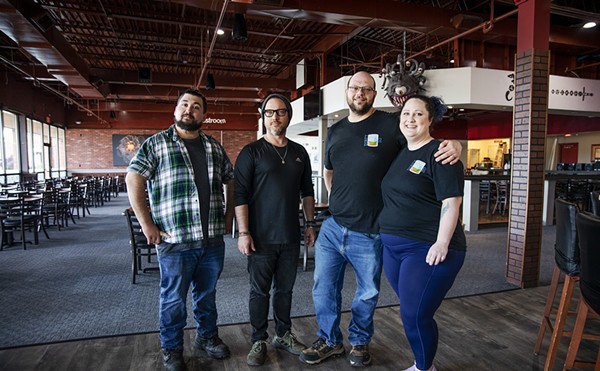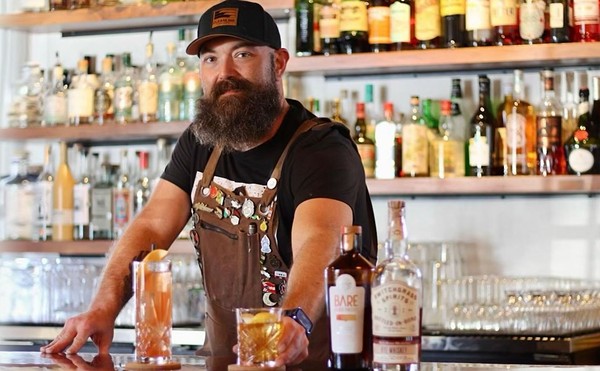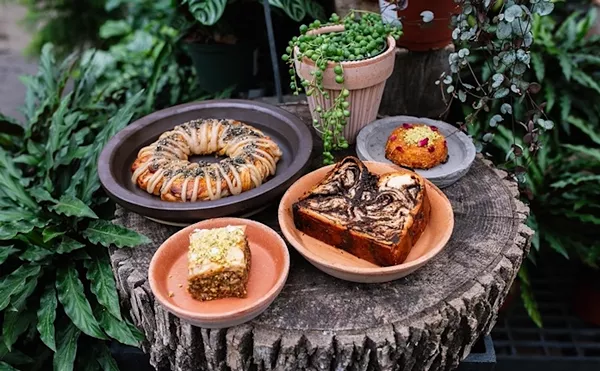McCormick & Schmick's Seafood Restaurant announced its arrival in St. Louis in February by installing a giant inflatable crab atop the parking garage at West County Center in Des Peres. The crab, named Jake, overlooked I-270, its claws beckoning drivers below to feast at the first area location of the upscale national chain. I suppose it was cute, or as cute as a crustacean can be. I found it vaguely threatening: All right, you Midwestern rubes. It's time you learn what seafood really is.
Bill McCormick and Doug Schmick founded their namesake restaurant in Portland, Oregon, in 1979. There are now 86 locations in 26 states, and since 2004 the company has been traded on NASDAQ. When I was a fresh-faced college graduate toiling at my first real job, my company held its Christmas party at the Bethesda, Maryland, location. I might have bought a new pair of khakis for the occasion.
It was kind of a big deal.
Though part of a new expansion of West County Center, which includes another national chain restaurant, Bravo! Cucina Italiana, McCormick & Schmick's corporate template conveys an old-school, clubby ambiance. The interior is dimly lighted and decked out in dark wood. The booths that ring the dining room feature privacy curtains. (On my visits no one had them drawn.) The décor includes old-timey advertisements and at least one illustration of a fox hunt. The fox-hunt picture comes with a poem, which I read aloud to my wife while the waiter ran our credit card.
McCormick & Schmick's trademark (aside from Jake the Crab) is its "Fresh List," found at the top of the menu, which details the day's recently arrived seafood. As your server will likely tell you, the St. Louis location receives two shipments of fresh seafood each day, while the menu is printed fresh daily and often reprinted based on what seafood arrives and what sells out.
On my visits, the fresh list featured shellfish — oysters from multiple locations, clams, scallops and mussels — as well as mako shark from Hawaii and halibut from Alaska. Shark, if you have never eaten it, is relatively meaty in texture, much like swordfish, with a mild flavor. To punch up that flavor, the kitchen blackened it, Cajun-style. The heat of the seasoning mix did give the fish some kick, but the seasoning's saltiness gradually overwhelmed me. The sides were unimaginative, though not entirely out of place considering the shark's texture: mashed potatoes and fried onions that had been lightly seasoned with chili powder.
The kitchen evinced a welcome lighter touch with the halibut, serving a small fillet in a citrus butter with kalamata olives over two cannelloni filled with butternut squash. The dish offered the interplay of flavors that was missing from the shark: a gentle but definite acid note, the salty olives, the sweet squash. I wished the textural contrasts were as interesting. Halibut is firm, but not so firm that it stood out against the cannelloni.
The menu takes time to navigate: The mako is listed in a section entitled "McCormick & Schmick's Specialties," the halibut in a box dubbed "Featured Wild Seafood." In addition, there is a list of "traditional" seafood entrées and a selection of steaks, as well as the appetizers, soups, salads, raw oysters and half a dozen "lite" entrées (one of which is a half-pound cheeseburger).
Among the house specialties are three pan-seared sea scallops in a pomegranate glaze. Despite the tart glaze, the scallops seemed flat, lacking distinctive flavor. They were served with white-truffle mashed potatoes, much too rich to complement the delicate shellfish. The use of pomegranate did show a little spark, which is more than can be said for oven-roasted Atlantic salmon stuffed with a mixture of Brie, blue crab and shrimp. The filling added a hint of sweetness and some creaminess, but not enough to elevate an otherwise OK piece of fish. The salmon, too, was served with mashed potatoes.
The crab-cake dinner, a "traditional" entrée, brought three decent-size cakes, made, as all crab cakes should be, with lump blue-crab meat. This is half the battle. Still, the kitchen had used a tad too much binding agent, mayo most likely, making the cakes slightly too creamy. Lobster ravioli, from the "Featured Wild Seafood" list, were plump with meat and no (or negligible) filler. These were served in a serviceable, if uninspired, tomato-Cognac sauce.
Oysters are available by the half-dozen, from one of half a dozen different locations (Long Island, Virginia, British Columbia and three separate Washington state locales). My table ordered a sampler of these locations. No one was especially impressed, and my wife described several of the oysters as gritty.
Oddly, the appetizer selection seems drawn more from Chili's or T.G.I. Friday's than a place where two people can easily spend more than $100 for dinner: coconut-fried shrimp, queso dip with blue crab meat and, God help me, toasted ravioli. Of course, there is fried calamari. I love fried calamari almost without reservation, but I was disappointed to see so many little fried bits mixed in with the squid. The sauces were lame: cocktail, mustard and something generically sweet.
Though the wine list features a good balance of red and white selections, always important for a seafood restaurant, there are few values to be had. Most bottles range between $50 and $100. The by-the-glass selection is broader than at most restaurants, with both five- and eight-ounce pours available.
In resolute old-school fashion, desserts are presented on a tray. The signature dessert is a "bag": a thin, dark-chocolate shell filled with white-chocolate mousse and fresh berries. This is best shared among three or four others. A crumble featuring local rhubarb was nicely tart, while the chocolate gooey-butter cake had the unctuous sweetness of the local favorite.
As the gooey-butter cake and toasted ravioli suggest, the kitchen has some leeway from the corporate template. There is a token effort to showcase local produce: Besides the rhubarb dessert, there is an appetizer with goat cheese from Baetje Farms in Bloomsdale and a fish dish that comes with "local wild mushrooms."
In the end, though, this is a seafood-intensive restaurant in the Midwest. McCormick & Schmick's most important vendor is its overnight-shipping firm. For a restaurant writer concerned about sustainability, it can raise troubling questions. There's the carbon footprint of the import-dominated menu and the twice-daily deliveries, and the fact that a couple of the current "Fresh List" species are deemed questionable by sustainability advocates. One of those, Atlantic salmon, is frowned upon for environmentally unfriendly farming practices. The other is the previously mentioned — and, yes, ordered and eaten — shark. For the record the jury's out on mako shark. While many shark species unquestionably are overfished, the National Marine Fisheries Service says mako likely remain at sustainable levels in U.S.-fished Pacific waters. (Another good resource concerned seafood lovers can consult is the Monterey Bay Aquarium's "Seafood Watch," accessible online at www.montereybayaquarium.org.)
Even setting aside 21st-century concerns like sustainability, McCormick & Schmick's overarching essence feels anachronistic: tried-and-true preparations (including not one but two tilapia dishes), unimaginative side dishes — tired of mashed potatoes? the crab cakes come with wild rice! — overpriced wine. Come to think of it, Jake the Crab may have been the perfect harbinger of McCormick & Schmick's: a relic of a time when fantastical creatures roamed the Earth.





